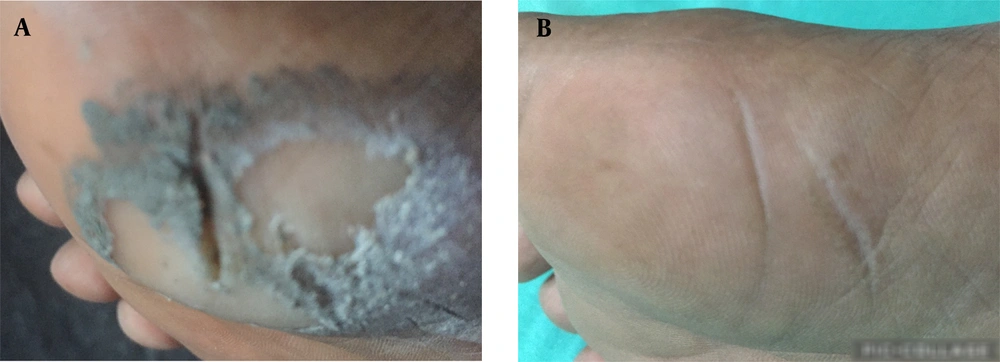Dear Editor,
Fissures are partial-thickness skin damage in the heels, particularly in the sole creases. This is common primarily due to a lack of moisture (xerosis) and hyperkeratosis (1, 2). The fissure can be deep, causing pain and delayed healing. Patients with the fissures are at an increased risk for developing infection, which could cause more severe problems, especially in patients with diabetes and peripheral vascular disease. A variety of treatments are recommended for treating the fissure, including keeping the part moist and approximating the fissure edges with cyanoacrylate glue along with supportive treatment (3, 4). The glue is an easy and effective tool in aiding the resolution of the fissures, but due to frequent wetting, it does not last long. Second, it should be applied carefully on the outer edge of the fissure rather than deep in the crevices, as the glue in the crevices may act as a foreign body barrier and delay healing. Third, it is a moist absorber due to its exothermic heat output when it comes into contact with moisture. The authors proposed the use of a surgical elastic adhesive bandage in this case. First and foremost, the fissures are treated medically for 7 to 10 days in order to eliminate the lesion infection. Following that, a lipogel antibiotic is applied to the fissure under aseptic conditions, and a suitable size surgical elastic adhesive bandage (SEAB) is patched over the fissure part after approximation of the fissure edges. The patient is then seen at weekly intervals for 4 to 6 weeks to apply a new bandage. With the bandage, the patient was able to go about their daily activities. After the SEAB, patients are advised to wear shoes while going outside and to prevent excessive wetness in order to keep the bandage stable and the fissure moist and free of dirt. The fissure usually heals in about 4 - 6 weeks Figure 1. We treated 2 cases (54/M and 41/F) of the pedal fissure successfully in those who had not a comorbidity or an underlying condition that causes a fissure. Thus, a surgical elastic adhesive bandage could be a quick and low-cost solution to the painful problem of pedal fissure (Figure 2A - F). However, this method has only been used effectively in two cases. To assess the efficacy of this bandage approach in the treatment of pedal/heel fissures, it would be better to conduct a case control study on a large number of patients of different ages, gender, occupation, and underlying disorders.


